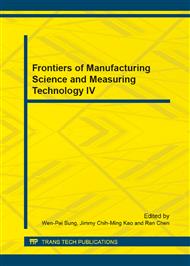[1]
Hu Qiming, Hu Runzi, Zhou Ping. Application of Inspection Robot Technology in Substation. Central China Electric Power, 2011. 5, (24),36-39.
Google Scholar
[2]
Lu Shouyin, Su Jianjun. Application of robot in substation Device Inspection. Robot Technique and Application, 2007, 5(1): 33-36.
Google Scholar
[3]
Yao Yong, Abnormal Sound Analysis And Discrimination of Power devices. Popular Utilization of Electricity, 2003(1),41.
Google Scholar
[4]
Zhao Li. Speech Signal Processing. Beijing, China Machine Press, (2003).
Google Scholar
[5]
Luan Shaowen. Feature Extraction of Abnormal Sound in Public Places. Computer Engineering, 2010, 36(7): 208-210.
Google Scholar
[6]
Xie Guodong, Yi Quan, Han Zhaofu, Yang Jianchang, Research on Battlefield Target Sound Recognition Technology. . Fire Control and Command Control, 2006, 28(3): 9-11.
Google Scholar
[7]
Zhang Minghan, Shi Weiren, Ding Ning. Research on Abnormal Sound Recognition Based on Learning, Chinese Journal of science of Instrument,2009. 6, 30(6), 37-40.
Google Scholar
[8]
C. Clavel, T. Ehrette, G. Richard. Events detection for an audio-based surveillance system, IEEE International Conference on Multimedia and Expo, (2005).
DOI: 10.1109/icme.2005.1521669
Google Scholar
[9]
Lv XiaoYun. Abnormal audio recognition algorithm based on MFCC and short-term energy. 2010, 3: 796-798.
DOI: 10.3724/sp.j.1087.2010.00796
Google Scholar
[10]
Liu Hui, Yang Juanan, Xu Xuezhong. A New Low Altitude Passive Acoustic Target Identifying Approach Research Based on MFCC and HMM. Journal of Projectiles; Rockets; Missiles and Guidance, 2007, (5): 217-222.
Google Scholar
[11]
Lv XiaoYun, Wang Hongxia. Abnormal audio recognition algorithm based on MFCC and short-term energy . Journal of Computer Applications, 2010. 30(3), 796-798.
DOI: 10.3724/sp.j.1087.2010.00796
Google Scholar
[12]
Chen Jie, Zhang Linghua, Wu Xihong. Feature Extraction Based on Wavelet Package-LPCC in speaker recognition[. Journal of Nanjin University of Post and Telecommunication (natural science) 2007. 12, 27(6), 54-56.
Google Scholar
[13]
Ai Changsheng, He Guangwei, Dong Quancheng, tool-wear on line monitoring cutting sound linear predictive cepstrum coefficient (LPCC) correlation analysis. China Mechanical Engineering, 20(17), 2009. 9, 2045-(2048).
Google Scholar


